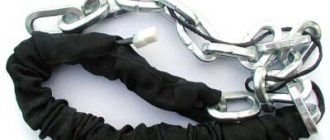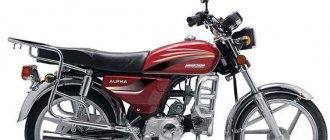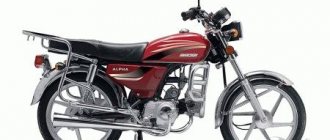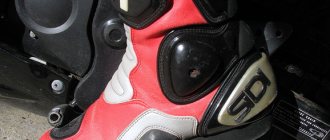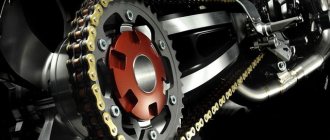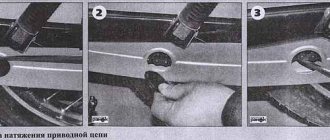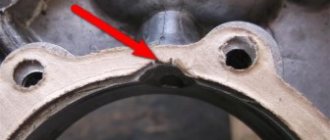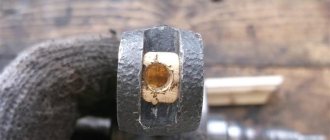Motorcycle Chain Lube Manufacturers
Lubricant manufacturers claim that motorcycle chemistry is selected depending on the area of use of the vehicle:
- to reduce friction;
- to prevent the adhesion of sand and dust;
- so that the lubricant dries quickly and does not leak out from under the seals.
For example, for enduro, the manufacturer provides lubricant properties that prevent the adhesion of sand and dust. Lubricant for sport bikes is designed to ensure that the chain structure operates efficiently at high speeds so that it does not leak from under the links. Taking into account the fact that in certain sports disciplines every second can affect the result, a sticky synthetic lubricant with increased grip (for use at high temperatures) has been developed for the fastest motorcycles.
The ideal lubricant can be selected according to the manufacturer's instructions in the instructions. According to the area of application, manufacturers divide the lubricant into the following types:
- universal;
- road;
- to sportbikes;
- for motocross and off-road motorcycles;
- to old motorcycles.
It is best to use special lubricants produced by such popular manufacturers as Liqui Moly, Motul, Motorex. The products of these brands are most in demand:
- Motul Chain Lube Factory Line. The most popular lubricant option from this company. Suitable for all chains, but especially for road and sports vehicles. Helps reduce friction and power loss, thereby increasing the service life of the product. Shows excellent grip in minutes.
- Motul Chain Lube Off Road. Standard and ring-shaped bushings are treated with this lubricant. Recommended for use in off-road motor vehicles. Thanks to the special composition, the adhesion of sand and dirt is prevented.
- Ipone Sand Chain. Aerosol lubricant, optimally suitable for motor vehicles when operating in sandy areas. When used, a protective film is formed to prevent abrasive wear and sand adhesion.
- Ipone Racing Chain Blue. High-quality Teflon-based product suitable for use in extreme situations at high speeds. It has excellent protective properties and is moisture resistant.
- Presto Ketten-Spray. Has excellent lubricating properties. It can even withstand the effects of household chemicals - after washing the motorcycle with foam, there is lubricant on the chain. The cylinder is designed for 6000-7000 kilometers.
How and with what to lubricate the chain?
After you have cleaned everything and the links have acquired a shine, as if from the factory, the chain needs to be lubricated. There are many options, and all of them are used by bikers in one way or another:
- Special lubricant in cylinders for motorcycle chains. Perfect option. After application, it flows under the seals, thickens, and is not thrown out by centrifugal force when driving. There are different lubricant options for sports, road, off-road motorcycles, as well as universal ones;
- Lubricants for extreme conditions, for example for motorcycles in Yakutsk and similar regions, are selected individually;
- Working out or transmission. It has lubricating properties, but it will splash your wheel, leg (and in some cases even your back) as soon as you leave the garage. The chain will have to be lubricated much more often than once every 500 km, since the lubricant simply will not linger in the oil seals;
- Solid oil - not intended for chains at all, it is very thick, it will not go into the oil seals, it will only create a sticky mass on the outside, which will become an excellent place for the accumulation of any abrasive in the form of sand;
- Kerosene-based graphite lubricant is a good, but outdated option;
- Automatic chain lubricator - used by many tourists who travel tens of thousands of kilometers during the season, for whom servicing a motorcycle chain every 500 km seems too frequent and irritating. It is fueled by the transmission, and therefore also dirty the rear wheel.
LUBRICATION PROCEDURE, ITS FEATURES
Let's figure out how and what to lubricate a motorcycle chain. First you need to heat it up. Let the motor run for 2 - 3 minutes. Then we turn it off, but the bike remains suspended. All parts are treated with lubricant. The chain is rotated twice, applying lubricant inside and outside. The lubricant thickens, making it difficult to wash it off the body or rubber. When choosing the best lubricant for your motorcycle chain, read the instructions on the can of the product.
Riding in wet weather, heavy mud or on dusty dirt roads requires frequent chain maintenance. The performance of your motorcycle depends on it. Cleaning and lubrication must be carried out every 1000 km. If you can't decide how to lubricate your motorcycle's chain, contact a specialist.
Unlike a car, behind many components - including the transmission, which uses a traditional chain drive. Without regular lubrication, it quickly wears out and gradually destroys other components - the rear wheel sprocket, gearbox and others. To ensure maximum longevity from your motorcycle, you should know how to properly lubricate and clean your chain. Following the recommendations given in the article will allow you to get rid of many problems and enjoy driving without thinking about expensive repairs.
Motorcycle chain
The chain transmission is used to transfer rotational motion from the drive sprocket to the rear wheel of the motorcycle. The movement of small equipment is carried out using bushing-roller chain mechanisms connected in a row structure. The design consists of metal links assembled into a single mechanism using bushings and rollers. The rollers rotate around the central axis of the bushing due to the contact of the teeth of the drive (front) sprocket.
A heavily worn chain contributes to high wear of the drive mechanism, and if it jumps off or breaks, it can break teeth, bend wheel spokes, and also, in the event of an impact on the gearbox housing, permanently disable it.
Systematic care of the chain mechanism will increase its operational life and protect the owner from involvement in emergency situations. To avoid wear and damage to the chain drive, it is necessary to carry out regular maintenance: visual inspection and lubrication of the working parts of the transmission.
REGULAR MAINTENANCE
It is worth remembering that only following all the rules for caring for a motorcycle will help you significantly extend the maximum life of your two-wheeled equipment. Regularly lubricating the chain, checking the condition of transmission components, and cleaning the transmission mechanism from dirt will help put off expensive repairs for tens of thousands of kilometers. If you neglect this need, this can lead to disastrous consequences - the gearbox may jam while in motion, which will cause an emergency. That is why many motorcyclists try to lubricate the chain as often as possible, trying to avoid trouble. If you don’t want to deal with such dirty work, you can entrust it to the specialists of a motorcycle service station - the advantage of this option will be the ability to carry out comprehensive diagnostics when servicing your equipment.
Before we talk about a motorcycle chain, let's remember what drives exist. Each of them has both its advantages and disadvantages.
Cardan. He requires minimal attention. It is necessary to change the oil regularly and check its level. It works quieter compared to other types. But there are also disadvantages to it. You can lose up to 15% of engine power, the gearbox is quite heavy. And it causes an unwanted reaction torque in the rear wheel suspension. This type of drive is used in touring motorcycles and choppers. Belt. No maintenance is required. You just need to monitor how the drive is tensioned and its wear. The advantage of this type of drive is the softness of the ride. But there is a very high sensitivity to pebbles and stones that get caught on the road between the belt and the pulley. Heavy motorcycles are found with this type of drive. Chain. It occurs most often. The drive chain is complex in that it requires constant and serious care. Every 500-1000 kilometers it needs to be cleaned and lubricated. If trips were made in rainy weather or off-road, you should immediately lubricate the chain additionally. There are two types of links in a chain, internal and external. In the first type, the plates are secured by a sleeve, and in the second - by a rod. The rods are passed through the bushings. Friction occurs in the roller-bushing and rod-bushing groups. The second group is filled with heat-resistant lubricant from the manufacturer, sufficient for the entire service life of the chain. And the first one is practically not protected. In addition, it is constantly influenced by the external environment. It is she who needs care.
TOP 5 popular chain lubricants
There are many controversial issues associated with chain maintenance: what and how to lubricate? how often do you do this? When is it better to change the chain, since lubrication will no longer help?
Answering these questions, experts were divided in opinion.
One thing is clear: lack of proper care has a negative impact on the smooth running and wear rate of chain sprockets.
To properly lubricate a chain, you need to have an understanding of its design and operating principle.
The chain consists of internal and external links. The internal ones consist of two side plates, rigidly connected to each other by bushings. Each bushing has a freely rotating roller.
The outer links include two plates connected by rods. The rods are passed through the bushings of the internal plates.
Thus, in the chain there are two groups of friction pairs that require lubrication - bushing/rod and bushing/roller.
In modern chains, the bushing/roller pairs are already filled with a special lubricant at the factory and are protected from negative influences by cuffs such as O-ring, X-ring or Z-ring. If they are preserved, the lubricant works throughout the entire life of the chain. However, other parts also need maintenance.
The frequency of their lubrication depends on the operating conditions of the chain, the quality of the lubricants, as well as the characteristics of the environment. For example, experts recommend lubricating motorcycle chains at least every 1000 kilometers (500 is possible) and every time after riding in the rain.
Before lubrication, you should prepare the chain: clean the sprockets, cassettes, rubber seals from dust and dirt so that their particles do not fall on the treated surfaces. After cleaning, the chain must be dried.
When applying lubricant, you must remember that its excess outside the roller is extremely undesirable, since abrasives will stick to the lubricant layer, causing premature wear of the chain elements.
Today there is a huge variety of chain lubricants: thick, liquid, aerosol. Thick ones are packaged in jars or tubes; they lubricate effectively, but are quite difficult to apply and require very thorough preliminary cleaning of the chain. Liquid materials (oils - in jars, bottles, oil dishes) can be applied pointwise using a syringe, which is very convenient. However, due to their consistency, they may bleed and may not provide adequate protection. In addition, oils thicken in the cold, which complicates the process of applying them.
Graphite grease
Chain lubrication has always been a problem for motorcyclists. Each type of lubricant has, in addition to its advantages, some disadvantages in its properties.
Graphite lubricant, which is also used by motorcyclists, lasts longer on the chain, but it is thick. And applying it is problematic. Most often, graphite lubricant is mixed with oils, and only then applied to the chain. But recently there has been a graphite lubricant, the advantages of which have already been appreciated by many motorcyclists.
The graphite lubricant device was patented in 2010. It is installed on the motorcycle pendulum, and lubrication occurs automatically in a thin layer. The device is filled with graphite-based lubricant. The chain structure is continuously lubricated. The composition of the graphite lubricant does not attract dirt and is consumed evenly. No excess or accumulation of lubricant is formed under the parts.
The action of this device lasts for six thousand kilometers, and after that the device changes. Even when driving in rain or snow, this lubricant is not washed off. And visually the chain looks like new - clean and constantly lubricated. The device weighs 400 grams and does not create any inconvenience when driving.
Graphite grease characteristics
Table 1. Physicochemical characteristics of graphite lubricant.
| Indicator name | Norm | Test method |
| 1. Appearance | Homogeneous ointment from dark brown to black color | According to clause 4.2 |
| 2. Dropping temperature, ° C, not lower | 77 | According to GOST 6793-74 |
| 3. Penetration at 25 ° C with stirring (60 double strokes), not less, mm × 10-1 | 250 | According to GOST 5346-78 (Method B) |
| 4. Corrosion test on plates made of steel grade 40 or 45, or 50 according to GOST 1050-88 | Withstands | According to GOST 9.080-77 |
| 5. Colloidal stability, % of released oil, no more | 5 | According to GOST 7142-74 |
| 6. Mass fraction of water, %, no more | 3 | According to GOST 2477-65 |
| 7. Shear strength at 50 ° C, Pa (gs/cm2), not less | 100 (1,0) | According to GOST 7143-73 (Method B) |
| 8. Viscosity at 0 ° C and an average strain rate gradient of 10 s-1, Pa × s (P), no more | 100 (1000) | According to GOST 7163-84 |
When to choose automatic lubrication?
Automatic lubrication systems are ideal if you are planning a long trip when you do not want to stop to treat the chain system with conventional sprays. In other cases, you can use conventional products - cheaper and suitable for use at home.
your motorcycle has a center stand
We put it on, if there is a special one, we put
the motorcycle
on it, if not, we use the side stand and periodically roll
the motorcycle
.
We will need the actual motorcycle chain
and cleaner, lint-free cloth and toothbrush.
We generously water the chain
of your
motorcycle
with cleaner, rub it with a toothbrush and then wipe it with a rag, until we go along the length of the entire chain.
By the way, under the chain on top along the entire swingarm of the motorcycle
there is a so-called “
slider
” on which part
of the chain lube
, as well as dirt and sand, settles; it is also highly advisable to clean it, although this is a dirty and labor-intensive task, but it needs to be done at least
once
a
motorcycle season
.
And so we clean the chain and let it dry for 15 minutes. When this time comes, take a bottle of chain lube
shake continuously for a couple of minutes, then sit under
the motorcycle
and begin to spray on each rubber band between the links
of the motorcycle chain
.
It’s better to do this from behind, or if you remove the chain protection from above, the protection is better; by the way, it will be easier to remove. Periodically roll the motorcycle
.
After all the gaskets have been lubricated, we give the motorcycle
stand for at least 15 minutes so that the lubricant hardens and becomes more sticky and viscous.
There are craftsmen who lubricate motorcycle chains
motor oil of high viscosity, but I want to say that this is monkey work, such lubricant will fly off the chain gaskets, they will dry out, crack and collapse, and the
plastic
or
chrome
of your
motorcycle
and your clothes will be stripped of the
“know-how”
chain lubricant It will not be possible to wash it, stains will remain. When lubricating a motorcycle chain
there is no need
to lubricate the rollers and links ; such lubrication will likely cause them to wear out more.
It is better to buy and use chain lube
special for motorcycle chains and containing Teflon, such lubricant sometimes does not fly off and is not washed off even in the rain and after many kilometers of travel.
The regularity of lubricating a motorcycle chain depends on the distance traveled, approximately once every 500-700 km, if you had to drive through sand and dust, then you need to clean and lubricate the chain upon arrival at the parking lot, after the rain you need to inspect the chain, if the lubricant is washed off, you need to lubricate it, if not, then after 100-200 km it’s better to lubricate it. A can of good chain lube with Teflon costs from 400 to 700 rubles, enough for half a motorcycle season or a season, maybe less if you ride a lot.
The cleaner is enough for two or three times, if the motorcycle chain is dirty, if you clean it regularly after the first time or the chain was new before cleaning, then it’s enough for 10 times.
Go to our motorcycle forum
ATTENTION – reprinting of this article is PROHIBITED, posting the original article on other resources will be suppressed! Author Kravchenko Dmitry
Buying lube and lubricating a motorcycle chain is one of the most trivial daily tasks of every motorcyclist. This needs to be done constantly, regardless of whether you want to ride or not - the chain of your motorcycle requires mandatory care.
So what should you lubricate with? And how should this be done to keep your chain in working condition for as long as possible? Today we will try to figure this out by studying motorcycle manuals, advice from experienced people and commercial data from well-known brands.
Aerosol lubricant
Make it a rule. The chain should be lubricated every five hundred to seven hundred kilometers.
There are many ways to lubricate a motorcycle chain. By properly caring for your motorcycle chain, you will greatly extend its service life. Don't forget to lubricate it after rainy weather or when driving off-road.
Motorcycle chain lubrication is carried out using various sprays, graphite lubricant and lithol. Aerosol lubricants are most often used. Few motorists use motor oil for these procedures. And there are reasons for this. Oil stains clothes and motorcycle wheels. And oils prepared using modern technologies have additives that practically do not wash off clothes. A chain lubricated with oil quickly dries out and breaks down.
To clean the chain, you can use kerosene or cleaners specially created for this purpose. But they cost much more. There is a difference from kerosene in that with the help of cleaners, dirt from under the seals is also washed off. You can't do this with kerosene. It's up to you to decide what you use to clean the chain.
Before starting the cleaning process, place the motorcycle on a special stand. The fact is that the rear wheel must spin during this work. Add a small amount of kerosene or cleaner to the chain and clean it with a toothbrush. Immediately remove any released dirt with a napkin. This procedure continues until the chain is completely clean. Along with the chain, the swingarm area of the motorcycle also becomes dirty. Don't forget to clean it too.
The cleaned chain must dry completely, this will take about ten to fifteen minutes. Now apply lubricant to the rubber bands of the chain, called oil seals. They must be elastic. And only then, using an aerosol can, apply lubricant evenly along the chain. To do this, spin the wheel. The grease dries within twenty minutes and becomes viscous.
Motul motorcycle chain lubrication
Manual method
Lubricating a motorcycle chain manually is the most common method among motorcyclists, since it does not require financial investments or special devices and allows cleaning to be done cheaply and cheerfully.
In addition to specialized products, the most popular cleaning agent is kerosene. It only effectively removes dirt, is absolutely safe for rubber parts, and if a drop of kerosene gets on the body, it can be quickly washed off without harming the paint. Special cans of cleaners produced by well-known brands will make cleaning a motorcycle chain a little easier and faster.
To clean and lubricate the chain, follow these steps:
Secure the motorcycle. In order to carry out lubrication correctly, you need to place the bike so that its rear wheel is suspended
Additionally, pay attention to the fastenings - you will need to rotate the wheel, but the motorcycle should not swing dangerously as you work. Secure it properly, protecting yourself from injury and your motorcycle from further damage;
Assess the condition of the circuit
To do this, just look, since most of the dirt and dust is visible to the naked eye. This will help you determine the scope and scope of work, understand the condition of the chain and sprocket as a whole and each individual link. It is best to carry out such an inspection regularly, always after driving on dusty roads or in bad weather;
Prepare tools and supplies for cleaning and lubricating the motorcycle chain. You will need kerosene or an alternative cleaner in a can, a motorcycle chain brush, a rag or any other rag, and a tray for excess oil and dirt. All this can easily be found in the garage or bought at the nearest market;
Start wiping down the chain. Use a gentle motion to spray the cleaner and wipe the links with a rag. Don't forget about the tray into which the cleaning waste will be drained, and repeat until all the links are clean. Only after this can you start lubrication;
Start lubricating the chain. The principle is the same - you apply an even layer of lubricant to the top and turn the rear wheel in neutral. For an even coating, you should make two circles, but you should not use too much lubricant - you will still have to remove the excess with a rag. Place a tray under the chain drive - stains on the garage floor that some substances leave are very difficult to wash off, and if they come into contact with the skin, they can cause irritation.
If you regularly clean and lubricate the chain, this will not only ensure smooth running, but will also increase the life of the chain.
Be careful and vigilant, otherwise cleaning may result in personal injury. So, the sprocket is often responsible for injuries - if you get carried away, you can accidentally pinch your fingers between its sharp teeth and the chain. Sometimes they catch on the material of the glove, and during cranking it gets chewed, which also does not end well for either the motorcyclist or his bike.
Lubricant replacement
Taking into account the recommendations of well-known manufacturers of motorcycle equipment, the chain mechanism must be lubricated at least every 500–1000 km.
Timely replacement of lubricant allows you to obtain the following advantages:
- Reduce noise from the operating unit.
- Improve the thermal characteristics of the drive.
- Reduce wear of rubbing parts.
Before performing lubricant replacement work, you need to thoroughly clean the surface of the chain. If you skip this procedure, the new grease will clog the dirt, which is saturated with abrasive particles. Solid inclusions, together with grease, will quickly turn the chain mechanism into an unusable part.
Cleaning the chain
Cleaning work on the chain drive must be carried out outdoors or in a ventilated room.
To complete the work you will need the following materials:
- detergent, better than factory-made;
- rags;
- brush or brush with stiff bristles;
- container for draining liquid.
The use of diesel fuel and white spirit as detergents is not prohibited.
Sequence of work:
- Place the motorcycle on a level surface and use a wheel to raise the rear wheel.
- Cover parts not involved in the work with a cloth.
- Apply or spray cleaner onto the surface of the links.
- Use a brush or brush to clean the surface of the chain and sprocket lugs.
- Wash off the old grease removed from the surface with a cleaner.
- Wipe the clean surface with a dry cloth or special cloth.
- Blow out the links with compressed air.
If the surface of the chain is too dirty, you can remove the drive completely and dip it in a container with diesel fuel, kerosene or white spirit. Keep the part in this solution for no more than 10 minutes. Exceeding this norm can lead to liquid getting into the rubber roller seals, which will negatively affect their technical condition.
Chain lubrication
It is better to lubricate the drive immediately after a trip. The lubricant will be better placed in the chain heated during movement, which guarantees the penetration of the oil composition into all the gaps of the mechanism.
Manufacturers of motorcycle equipment recommend using SAE 80W-90 transmission oil or a specialized aerosol lubricant to lubricate parts.
Widget from SocialMart
To complete the work you will need:
- lubricant;
- rags:
- tray.
Process sequence:
- We hang out the equipment. Lubrication must be performed with the neutral mode turned on.
- We install the tray and cover the motorcycle with a thick rag (except for the chain).
- We first apply the aerosol mixture to the internal links of the lower section of the drive. When applying lubricant, the cylinder should be at a distance of 5–7 cm from the working surface. After treating the inside of the chain, spray lubricant on the outer surface.
- We apply transmission lubricant using a compression syringe, squeezing the mixture into the gaps between the links and the body of the rollers, and then squeezing it from above, between the outer and inner plates of the links.
Upon completion of lubrication, wipe the surface of the drive mechanism with a dry cloth and allow the lubricant to adhere to the metal parts (12–20 minutes). Taking into account the last requirement, we can conclude that it is better to carry out lubrication work before parking the equipment.
How to lubricate a chain
As the vehicle moves, the chain rollers move along the teeth of the sprockets. Friction forces arise between the rubbing surfaces of the mechanism, which contribute to an increase in the temperature of the metal parts. The higher the speed of the motorcycle, the greater the likelihood of heating the grease embedded in the chain rollers.
The situation can be aggravated by dirt and dust on the surface of rubbing parts. The overheated lubricant located in the mechanism bushings is squeezed out from the friction units, where under the influence of high temperature it will coke on the roller bushings. Carbon deposits on the links will prevent the chain from moving freely, the rollers will jam, and the chain will break.
To avoid transmission breakdowns, it is necessary to carefully monitor the technical condition of the drive mechanism:
- cleanse from dirt;
- wash the surface of the links with detergent compounds;
- change the lubricant in a timely manner.
The above list of basic work performed during motorcycle servicing refers to the periodic manual maintenance method. Some modern models are produced with an automatic oil supply system already installed on the vehicle, which lubricates the moving parts of the chain drive during movement. For later designs, the retail chain sells ready-made mechanical lubrication kits for the drive, which can be installed at the nearest service station or at home.
A generally accepted automatic lubrication system designed specifically for motorcycle equipment is a set of equipment from the English company Scottoiler. The main basic element of the universal set, the oil container (125 ml), can be mounted in any free space on the motorcycle frame.
The equipment is brought into working condition by means of a vacuum, which is formed in the system due to the functioning engine. Oil fluid from the reservoir is supplied through a tube to the links of the rotating chain, and automatically lubricates the rubbing surfaces. The consumption of lubricating fluid (1–2 drops per minute) is regulated by a dispenser installed on the line. The frequency of fluid flow is affected by the motorcycle's driving mode.
Cleaning
Experts recommend starting to clean the chain after a short drive - an hour will be enough. This will allow the chain to warm up to the desired temperature, making its lubricant less thick. In this state, it will be much easier to wash all deposits from the chain, and the new lubricant will be able to penetrate much deeper into the friction pairs. If you want to wash the motorcycle at the same time as cleaning the chain, do this only after servicing the transmission, since during such work a lot of dirt and grease will leak onto the body of the bike. There are two main ways to clean a chain, using different tools.
Manual method
The most common method among Russian motorcyclists is cleaning the chain with a toothbrush. Instead, you can take a narrow shoe brush with soft fibers or a special tool sold in a motorcycle parts store. Do not use metal brushes or tools with very coarse fibers as they can easily damage chain components.
You will also need to purchase a cleaning liquid - Liqui Moly, Hi-Gear and Motul have suitable spray cans in their range. If you don’t have such a product at hand, the chain can be cleaned with kerosene, but you should prepare for a significant increase in the labor intensity of such work. You cannot use gasoline to clean the chain, as this will lead to the dissolution of the O-rings, bushings and seals - as a result, the part will have to be thrown away.
The motorcycle is mounted on a stand or on a suspension - the rear wheel must be in the air. The can of liquid should be brought in from the wheel side. Its nozzle should be directed outward, since contact with such an aggressive chemical compound on the wheel can be dangerous for the rubber. After applying the liquid to the upper part of the chain, spin the wheel and repeat the procedure so that the entire part is covered with a special cleaning agent
After waiting approximately 5 minutes, begin brushing the transmission, paying particular attention to gaps and seals.
If you need to learn how to clean a chain with kerosene, then you should understand that in this case you will have to spend a lot more time. The liquid is applied to the part in a thin stream, and care must be taken that its splashes do not fall on the wheel. After 5 minutes, begin to thoroughly remove the dirt with a brush, trying to penetrate the fibers as deeply as possible. If it was not possible to completely clean the chain in this way, it will have to be removed, which will take a lot of your time and effort.
Automation
For those who are interested in the best way to clean a chain, we can recommend using a special device - this is produced by KETTENMAX, as well as some other manufacturers of motorcycle accessories. The bike needs to be lifted by hanging the rear wheel, and then started. The device is attached to the chain - inside there are special rollers and brushes that allow you to pass the chain while simultaneously cleaning it from all possible deposits. At the top there is a tube for supplying cleaning liquid - it can be either a special product supplied in the kit or regular kerosene. There is a tube at the bottom for draining dirty cleaning liquid - it is better to lower it into a tray or half-liter bottle.
After making sure that the device is securely attached to the chain, engage first gear, but do not add gas. Now your task will be to ensure an even flow of cleaning material into the device - it must be gradually poured or injected into the upper tube, making sure that the liquid does not fall on the motorcycle itself. After about five minutes, the chain will be completely cleaned, after which you need to turn off the gear and turn off the motorcycle engine.
Before lubricating the chain, you will need to rinse off any remaining cleaning fluid - otherwise the oil will not be able to adhere to the part. To do this, use water at room temperature - it is better to pour it out of a simple plastic bottle in a thin stream, gradually turning the chain. Do not use a high-pressure washer under any circumstances - it very quickly destroys the motorcycle transmission, shortening its service life. After washing, carefully dry the chain with a non-abrasive material - a microfiber cloth will do.
Lubrication
Before you begin, you should find out what you can use to lubricate the chain on your motorcycle. There are many types of products that are applied to the chain drive to increase its reliability and durability. The best option would be to select a lubricant based on the manufacturer’s recommendations specified in the instructions. However, you can also follow the instructions on the oil can - most manufacturers provide the following types of lubricant:
- Universal;
- Road;
- For sportbikes;
- For motocross and off-road motorcycles;
- For old motorcycles.
If you cannot figure out which lubricant is ideal for your motorcycle, it is better to consult a specialist.
It is best to purchase lubricant in spray cans - this will allow the oil to penetrate all joints and friction pairs, significantly increasing the durability of the motorcycle transmission. If you bought the product in a canister or bottle, you should additionally purchase an inexpensive can of compressed air, which can be used to increase the efficiency of chain lubrication. Some riders find that they can significantly improve transmission reliability by using a very thick grease. This is a very common misconception - excessively thick lubricant quickly lags behind the seals and flies out of the chain, getting on the motorcycle body and the driver’s clothing.
Methodology
If you are interested in how to lubricate a motorcycle chain, then you need to warm it up slightly - running the motorcycle on the suspension for 2-3 minutes will be enough. After this, it is better to turn off the engine, but the bike should remain suspended. Lubricant is applied to the upper branch of the chain, trying to treat all internal parts of the part - oil seals, seals, friction pairs and others. It is advisable to rotate the chain twice, gradually applying lubricant so that the oil spreads evenly along its outer and inner sides. The grease should not get on the motorcycle body, engine, wheels and rubber, as it thickens very quickly and will be very difficult to remove.
After completing the procedure, excess liquid must be removed using a soft cloth. Do not take paper napkins under any circumstances - they tear and their parts remain inside the chain, significantly reducing its durability. Motorcycle chain lubricant must be distributed evenly throughout the transmission mechanism, otherwise the part will wear out very quickly and also destroy the sprockets. After completing the procedure, wait 15 minutes for the lubricant to thicken - after making sure of this, you can start the motorcycle engine and go for a break-in.
Additionally
Quite often, beginners have a question about how often to lubricate the chain. It is impossible to give a definite answer to this question, since it all depends on the driving style, as well as on the type of material used. For example, grease is applied to the chains of domestic motorcycles once every approximately 500 kilometers. If we are talking about a high-quality spray for imported motorcycles, it is enough for them to treat the chain once every 1–3 thousand kilometers. The following circumstances can significantly reduce the specified time frame:
- Off-road driving;
- Wheelie;
- Long driving at high speed;
- Storing the motorcycle in inappropriate conditions.
If, when choosing a lubricant, you have already determined which one is better and have established the frequency of transmission maintenance, all you have to do is find out what other procedures should be performed simultaneously with cleaning the chain. Before lubrication, it is worth determining the degree of chain tension - to do this, you need to measure the maximum sag of its lower branch. The normal level of sagging will be 15–25 mm - if it is exceeded, it is worth tightening the chain drive using a special tool.
It is also worth assessing the condition of the sprockets - if they show severe wear, it is better to replace them immediately. Remember that severe wear on these parts can cause transmission failure and costly repairs. If there is damage to the chain, it should also be replaced - usually this work is performed when the mileage reaches 10-15 thousand kilometers, but careless operation of the vehicle can lead to accelerated wear.
If you are not comfortable with periodically lubricating your motorcycle chain with oil, you can purchase an automatic lubricant supply device. It is installed near the gearbox and performs two functions simultaneously, cleaning the part from contaminants that have fallen on it, as well as supplying oil and preventing accelerated wear of the transmission. The cost of such a device reaches approximately 9-12 thousand rubles, but it will help you save a lot of time and effort. However, it is worth remembering that the use of automation does not eliminate the need to clean the chain if it is heavily soiled - this procedure will have to be performed after driving off-road or on bad roads.
What and how to choose?
A poorly maintained chain will result in poor running smoothness and higher wear. It is worth noting that this element is not cheap, so it is better to take care of it in a timely manner than to replace it six months later. There is a large selection of lubricants by brand, but first we will look at their features in terms of composition, type and technical characteristics. Modern motorcycle chain lubricant can be:
- Aerosol: available in a can, it penetrates well into hard-to-reach chain components, but when sprayed, it can also get on the rim or tires.
- Liquid: this lubricant comes in a bottle in the form of an oil can, so it can be used point-by-point, treating exactly the required gaps. But such lubricants can thicken in the cold.
- Two-component: comes in the form of an oil bottle, has a thick structure, but easily penetrates the chain rollers, can be used for spot treatment. Due to the solvent in the composition, it takes time to dry.
- Thick: This lubricant comes in a jar or tube and is not very convenient to use due to its thick texture.
Repel water, resist moisture, protect the chain from sticking sand and dirt, lubricate it and prevent premature wear - these are the main requirements that a motorcycle chain lubricant must meet. Which is better? Let's try to figure it out below.
Liqui Moly
The popular brand Liqui Moly offers a wide selection of lubricants that significantly increase the service life of motorcycle chains. Consider the range offered by this German brand:
- Motorrad Kettenspray Grand Prix Grun – This Liqui Moly motorcycle chain lubricant comes in spray form, making it easy to use. Its purpose is to lubricate the element, protecting it from wear and stretching. It adheres well to the surface and remains on it even at high speeds. In addition, the coating will be resistant to high loads and temperatures during operation.
- Kettenspray chain care spray can be used for initial and regular treatment of motorcycle chains. Thanks to this product, you can ensure proper care of the rubber seals of the chain links. Special ester components in its composition increase the stickiness of the lubricant and the ability to retain it on the surface.
- Motorbike Ketten-Reiniger is a product that quickly and, most importantly, gently cleans the chain of old lubricant. After application, the cleaner evaporates without the chain losing its density.
